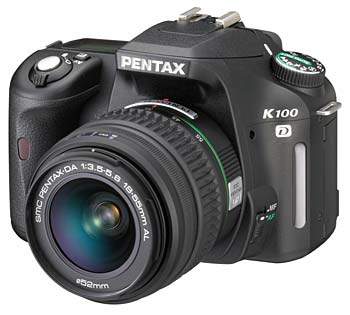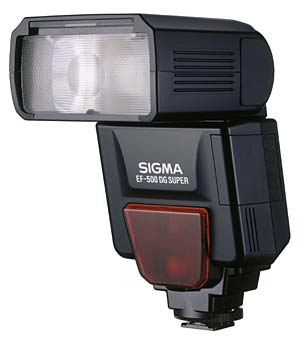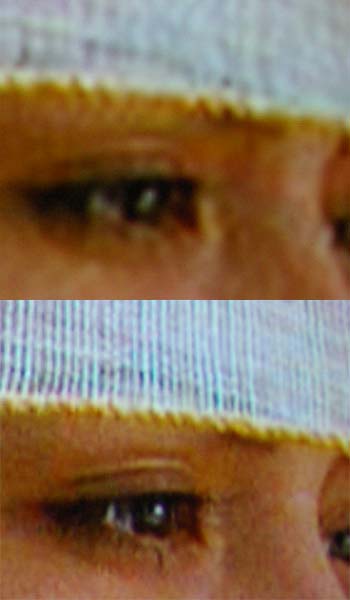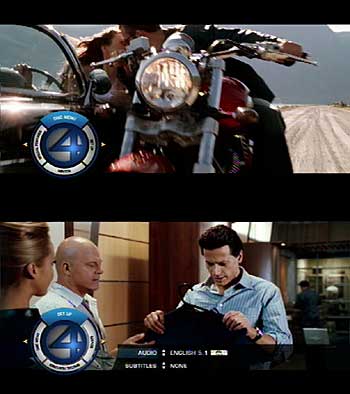I received an email today, originating from Panasonic, in which polite issue was taken with a statement I had made in a review I had written of the Panasonic DMP-BD100 Blu-ray player. The statement was: ‘there is five times as much detail in a Blu-ray movie than there is in its DVD equivalent.’
Panasonic noted that ‘Technically speaking, “a Blu-ray disk can have up to 10x the resolution of a conventional DVD”.’ Naturally, I disagree. What follows is based largely on my response.
This is correct — potentially, and in a limited range of circumstances.
If the original source was captured using a 1080p50 camera, then there would indeed be 10 times the amount of data compared to a 576i50 camera (pps= pixels per second):
576i50 capture: 720 pixels x 288 pixels x 50 hertz = 10,368,000pps
1080p50 capture: 1,920 x 1,080 x 50 = 103,680,000pps
Ratio is 10:1
It is actually even higher in the US where 60 hertz systems are used:
480i/60: 720 x 240 x 60 = 10,368,000pps
1080p60: 1,920 x 1,080 x 60 = 124,416,000pps
Ratio is 12:1
So, to be completely accurate, one should say that Blu-ray/HD DVD can deliver up to 12 times the number of pixels.
So that’s the potentiality, and all it awaits is the extensive use of 1080p50 or 60 video cameras.
But back to the present. The great majority of DVD and Blu-ray/HD DVD content is derived from either film, or film-like video camera (eg, Episodes 1-3 of Star Wars). These run at 24 frames per second.
Let us consider one film frame. With, say, 576i50 telecining, this is indeed captured in each cycle at a resolution of only 720 by 288 pixels, to constitute the first field. But there are two fields. The following cycle also captures only 720 by 288 pixels, but these are actually different pixels to those captured in the first cycle. The first cycle captures one set of 288 horizontal lines, reaching from the top to the bottom of the screen, while the second cycle captures the in-between set of lines. So the total amount of information captured for that frame is 720 by 576, which is 414,720 pixels.
With 1080p telecining, you would be mad to capture the exact same film frame twice. All that does is double the amount of data to store. So each film frame is captured once, at full HD resolution of 1,920 by 1,080, which is 2,073,600 pixels. All film-sourced content on Blu-ray discs, which I have confirmed with Twentieth Century Fox, Warner Bros and Sony Pictures Entertainment, will be presented on Blu-ray in the 1080p24 format.
So, right now, with virtually all currently available content, and for the great majority of content into the forseeable future, the number of pixels per frame for most Australian DVDs and Australian BDs are:
DVD: 720 x 288 x 50 = 10,368,000pps
BD: 1,920 x 1,080 x 24 = 49,766,400pps
Ratio is 4.8:1
This is being unfair to BD because the DVD is running the movie around 4% fast (actually, 4.1666 repeated). So in terms of actual total data presented per film frame we have:
DVD: 720 x 576 = 414,720 pixels
BD: 1,920 by 1,080 = 2,073,600 pixels
Ratio is exactly 5:1
I think that justifies my claim (note, I specifically said ‘Blu-ray movie’). The important point to remember is that everything is limited by its source. A 1080p projector can’t really lift a 576i DVD out of its humble origins, and a 1080p60 BD can’t generate more data out of a 24 frame per second movie than was originally contained in the frame.
But that does bring me to one point which: the output of the current Blu-ray players is 1080p60 or 1080i60. In either case, this damages the 1080p24 source.
The reason is that the 24 film frames in each second must be translated into 60 BD frames per second. How to do this? Consider four sequential film frames, which I’ll call A, B, C and D. When shown in a cinema, a technique of double shuttering is used to eliminate flicker. This is straightforward: each film frame is exposed twice, thus: A A B B C C D D. So in modern terms, you might say that the output of a cinema film projector is 48p.
But with the DMP-BD60’s output at, say, 1080p60, extra frames are required (24 is not a factor of 60). So the film frames are shown as so:
A A A B B C C C D D
As you can see, every second film frame is displayed for 50% longer than the intermediate ones. This is painfully obvious when watching Blu-ray discs. Camera pans become jerky, and so does other movement which should be smoothly moving. Watch the credits roll up on the end of a DVD movie, then watch them on a BD and the difference will be obvious.
The obvious solution is to produce a Blu-ray disc player capable of outputting 1080p24 (or 1080p48, but that’s unnecessary). I note that most modern 1080p display devices are capable of accepting 1080p24 input. So why won’t current Blu-ray players deliver it?

 Since then it has been to Bangkok, Hong Kong, Singapore, Los Angeles, London, Paris, Tokyo, Osaka, and a few other places, and served me well. But it was always a bit limited. I learned photography on a Pentax K1000 SLR (with which my eldest daughter is now also learning photography). Fully manual, it is the kind of camera you could still use after civilisation collapses, requiring no batteries at all.
Since then it has been to Bangkok, Hong Kong, Singapore, Los Angeles, London, Paris, Tokyo, Osaka, and a few other places, and served me well. But it was always a bit limited. I learned photography on a Pentax K1000 SLR (with which my eldest daughter is now also learning photography). Fully manual, it is the kind of camera you could still use after civilisation collapses, requiring no batteries at all. And then there was the issue of a flash. The K100D has a built-in pop up flash, which is okay I suppose in an emergency. But it is just no good at all for taking pictures of home entertainment equipment, producing bright reflections and such. A flash attached to the hot shoe, fitted with a swingable head, seemed to be the answer.
And then there was the issue of a flash. The K100D has a built-in pop up flash, which is okay I suppose in an emergency. But it is just no good at all for taking pictures of home entertainment equipment, producing bright reflections and such. A flash attached to the hot shoe, fitted with a swingable head, seemed to be the answer. So then I did some experiments. The flash always worked properly if the aperture on either lens was set to less than F4.5. It also always worked properly if the head was significantly swivelled, or significantly swung up. But if pointed directly at the subject, with an aperture of F4.5 or greater, it just would not work at all. How’s that for strange!
So then I did some experiments. The flash always worked properly if the aperture on either lens was set to less than F4.5. It also always worked properly if the head was significantly swivelled, or significantly swung up. But if pointed directly at the subject, with an aperture of F4.5 or greater, it just would not work at all. How’s that for strange! Well, judging by the detail of the pictures shown to the right, it most certainly looks like Blu-ray is much better than DVD. The discs concerned are the Region 4 DVD of
Well, judging by the detail of the pictures shown to the right, it most certainly looks like Blu-ray is much better than DVD. The discs concerned are the Region 4 DVD of  Blu-ray has many wonderful things going for it, especially the sheer detail of the picture quality (more on this on another day). But one of the coolest things for me are the pop-up menus.
Blu-ray has many wonderful things going for it, especially the sheer detail of the picture quality (more on this on another day). But one of the coolest things for me are the pop-up menus. Just received a press release from Topfield. It has now released its
Just received a press release from Topfield. It has now released its  When describing the differences between standard definition and high definition TV, I generally say that the higher resolution doesn’t so much deliver more detail, but that the detail that is there is cleaner and more nicely defined.
When describing the differences between standard definition and high definition TV, I generally say that the higher resolution doesn’t so much deliver more detail, but that the detail that is there is cleaner and more nicely defined. Naturally, noticing this footnote (I am bit of a nerd at these things, and read the press release during the drinks before the event starts), I was prompted to ask: are Aussie HD DVDs going to be ’60 hertz’ releases. By 60 hertz, I mean with a native frame rate of 24 frames per second. Films encoded on a disc at 24fps simply cannot be shown at 50 hertz without an enormous amount of processing (or, theoretically at least, some shortcuts that would result in horrid picture quality).
Naturally, noticing this footnote (I am bit of a nerd at these things, and read the press release during the drinks before the event starts), I was prompted to ask: are Aussie HD DVDs going to be ’60 hertz’ releases. By 60 hertz, I mean with a native frame rate of 24 frames per second. Films encoded on a disc at 24fps simply cannot be shown at 50 hertz without an enormous amount of processing (or, theoretically at least, some shortcuts that would result in horrid picture quality).